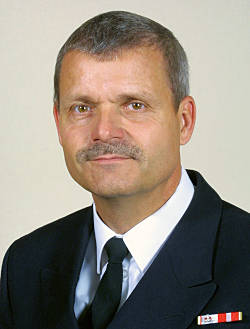WASHINGTON — The day before the congressionally mandated deadline to put all Base Realignment and Closure Commission recommendations into effect, the commander who oversaw the closing of Walter Reed Army Medical Center isn’t kicking back with a sigh of relief.
For Navy Vice Adm. (Dr.) John M. Mateczun, commander of Joint Task Force National Capital Region Medical, some of the toughest challenges are just beginning.
Mateczun was responsible for one of the most sweeping transformations in military medicine with the closure of the iconic Walter Reed hospital.
With all its patients, staff and health care services moved to what is now known as the Walter Reed National Military Medical Center in Bethesda, Md., and the new Fort Belvoir Community Hospital in Virginia, he now has set his sights on his next, post-BRAC goal.
“This is a new beginning,” he said. “We now have the opportunity here in the national capital region to form the first truly integrated regional delivery system within the military health system.”
Getting to this point was no small feat. Since BRAC became law in 2005, 2.6 million square feet of new construction and 472,000 square feet of renovations have taken place on the Bethesda campus and Fort Belvoir to accommodate the new, expanded missions there.
Meanwhile, the civilian workforces were consolidated into one Defense Department workforce. Mateczun said the merger will benefit workers by opening up more career opportunities and enabling them to transfer more smoothly between the two facilities.
The merger also will also be a plus for the hospitals, he said, helping them better attract and retain experienced workers with highly sought-after skills.
With the facilities and workforce in place, both the Walter Reed National Military Medical Center and Fort Belvoir Community Hospital are providing care for the former Walter Reed patients.
A convoy of ambulances transferred the last inpatients at that center to Bethesda Aug. 27, one day ahead of schedule to beat the approaching Hurricane Irene.
The final emergency-room patient at Fort Belvoir’s DeWitt Army Community Center was transferred to the new Fort Belvoir Community Hospital on Aug. 31. That same day, the staff performed its first operation and also delivered its first baby in the new facility, Mateczun said.
The last pieces of medical equipment are being moved from the old Walter Reed, much of it being redistributed to the Bethesda or Belvoir facilities. Back in 2008, BRAC planners estimated that $54 million in equipment would be transferred, but the actual figure exceeds $100 million, Mateczun reported.
With both facilities now running at full-throttle, he said now is the time to generate some of the efficiencies BRAC was designed to provide.
Many of those savings will come through consolidated support services such as human resources and facilities operations.
While designed to improve efficiency and save money, Mateczun said the consolidation also will promote patient care.
The nature of the consolidations, with highly specialized care delivered at Bethesda, ensures medical staffs providing that care have sufficient patient loads to remain at the top of their game, he said.
In addition, three electronic medical networks in use at facilities within the Washington, D.C., area are being combined into one joint medical network. This, Mateczun said, will enable providers at various clinics and hospitals to more easily access and share patient records.
Other initiatives will make it more convenient for patients to get care. For example, a consolidated appointment and referral center being stood up will provide a user-friendly, standardized way for patients to schedule appointments at either facility.
A major post-BRAC emphasis is on taking these efforts to the next level to reach a “world-class standard” in medical care, Mateczun said.
That standard — mandated by Congress in the wake of the 2007 Walter Reed scandal as BRAC initiatives already were under way — raises the bar in patient care.
Among its recommendations were the new wounded warrior lodging on the Bethesda campus and private hospital rooms that weren’t part of the original BRAC plan.
Subsequent congressional recommendations direct that parts of Walter Reed National Military Medical Center not impacted by BRAC also be raised to this world-class standard.
That, Mateczun explained, involves upgrading additional buildings on the Bethesda campus — all built or last renovated before 1975.
As part of that new standard, the last of existing two-patient rooms are being converted into private rooms.
In addition, individual patient rooms at both Bethesda and Fort Belvoir will soon be turned into “smart suites.” These rooms will be equipped with technology that enables caregivers to monitor patients’ vital signs electronically and even to recognize when a patient has gotten out of bed.
This technology benefits patients, too, who will be able to refer to a monitor in their room to identify who enters it and whether, for example, it’s a doctor, nurse or food-service provider.
“It is a patient’s right to know who is in their room and what they are doing there. And this technology will allow them to do that without having to necessarily question anyone,” Mateczun said.
Mateczun said he’s looking forward to seeing the Walter Reed National Military Medical Center and Fort Belvoir Community Hospital set a new standard for military medicine.
“So this is our next step, making the improvements required in the comprehensive master plan to provide world-class care for our beneficiaries,” he said.
“We are committed to keeping the covenant we have with America’s sons and daughters who come home wounded from Iraq and Afghanistan,” he said. “And that is what the BRAC projects have been about. We are intent on making sure that we meet the congressional mandate to a world-class capacity and infrastructure, both here at Bethesda and on Fort Belvoir.”
Source:
U.S. Department of Defense
Office of the Assistant Secretary of Defense (Public Affairs)

 von
von 
